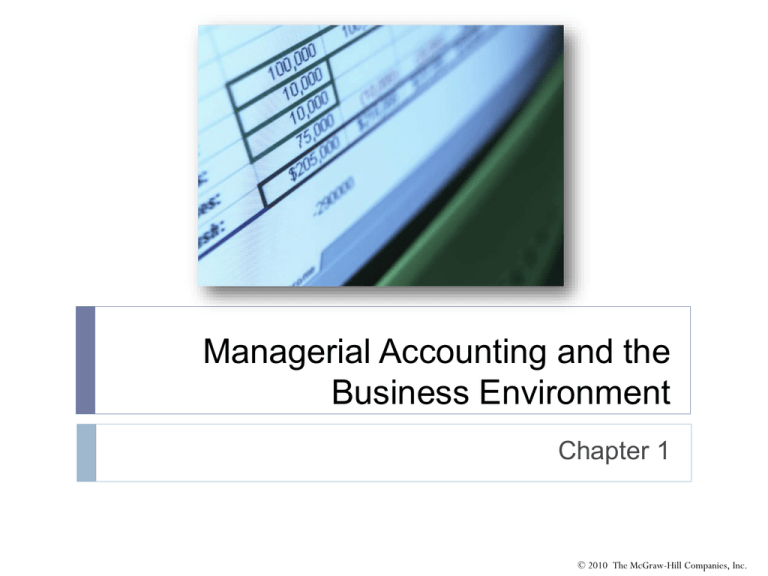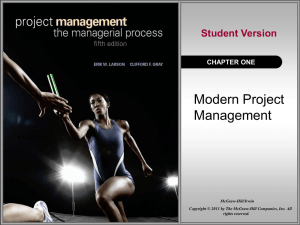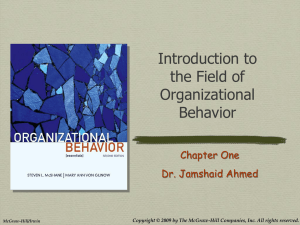Managerial Accounting and the Business Environment Chapter 1
advertisement

Managerial Accounting and the Business Environment Chapter 1 © 2010 The McGraw-Hill Companies, Inc. $350 $300 Imports to the US (billions) $250 Canada $200 China Germany Japan $150 Mexico United Kingdom $100 $50 $0 1995 McGraw-Hill/Irwin 2000 2005 2007 Slide 2 $300 Exports from the US (billions) $250 $200 Canada China $150 Germany Japan Mexico United Kingdom $100 $50 $0 1995 McGraw-Hill/Irwin 2000 2005 2007 Slide 3 Internet Usage The Internet fuels globalization by providing companies with greater access to geographically dispersed customers, employees, and suppliers. As of 2008, more than 78% of the world's population was still not connected to the Internet. McGraw-Hill/Irwin Slide 4 Strategy A strategy is a “game plan” that enables a company to attract customers by distinguishing itself from competitors. The focal point of a company’s strategy should be its target customers. McGraw-Hill/Irwin Slide 5 Customer Value Propositions McGraw-Hill/Irwin Customer Intimacy Strategy Understand and respond to individual customer needs. Operational Excellence Strategy Deliver products and services faster, more conveniently, and at lower prices. Product Leadership Strategy Offer higher quality products. Slide 6 Learning Objective 1 Understand the role of management accountants in an organization. McGraw-Hill/Irwin Slide 7 Organizational Structure Decentralization is the delegation of decisionmaking authority throughout an organization. Corporate Organization Chart Board of Directors President Purchasing Personnel Vice President Operations Chief Financial Officer Treasurer McGraw-Hill/Irwin Controller Slide 8 Line and Staff Relationships Line positions are directly related to achievement of the basic objectives of an organization. Example: Production supervisors in a manufacturing plant. McGraw-Hill/Irwin Staff positions support and assist line positions. Example: Cost accountants in the manufacturing plant. Slide 9 The Chief Financial Officer (CFO) A member of the top management team responsible for: Providing timely and relevant data to support planning and control activities. Preparing financial statements for external users. McGraw-Hill/Irwin Slide 10 Learning Objective 2 Understand the basic concepts underlying Lean Production, the Theory of Constraints, and Six Sigma. McGraw-Hill/Irwin Slide 11 Process Management A business process is a series of steps that are followed in order to carry out some task in a business. R&D Product Design Customer Manufacturing Marketing Distribution Service Business functions making up the value chain McGraw-Hill/Irwin Slide 12 Process Management There are three approaches to improving business processes . . . Theory of Constraints (TOC) Lean Production McGraw-Hill/Irwin Six Sigma Slide 13 Traditional “Push” Manufacturing Company Forecast Sales Make Sales from Finished Goods Inventory McGraw-Hill/Irwin Order components Store Inventory Store Inventory Produce goods in anticipation of Sales Slide 14 Traditional “Push” Manufacturing Company Traditional “push” manufacturing Raw materials Large inventories Work in process Materials waiting to be processed. Finished goods Completed products awaiting sale. Partially completed products requiring more work before they are ready for sale. McGraw-Hill/Irwin Slide 15 Lean Production Identify value in specific products/services. Identify the business process that delivers value. The lean thinking model is a five step approach. Organize work arrangements around the flow of the business process. Continuously pursue perfection in the business process. Create a pull system that responds to customer orders. McGraw-Hill/Irwin Slide 16 Lean Production The five step process results in a “pull” manufacturing system that reduces inventories, decreases defects, reduces wasted effort, and shortens customer response times. Customer places an order Create Production Order Generate component requirements Goods delivered when needed Production begins as parts arrive Components are ordered McGraw-Hill/Irwin Slide 17 Lean Production Lean thinking can be used to improve business processes that link companies together. The term supply chain management refers to the coordination of business processes across companies to better serve end consumers. McGraw-Hill/Irwin Slide 18 Theory of Constraints A constraint (also called a bottleneck) is anything that prevents you from getting more of what you want. The Theory of Constraints is based on the observation that effectively managing the constraint is the key to success. The constraint in a system is determined by the step that has the smallest capacity. McGraw-Hill/Irwin Slide 19 Theory of Constraints Only actions that strengthen the weakest link in the “chain” improve the process. 2. Allow the weakest link to set the tempo. 3. Focus on improving the weakest link. 1. Identify the weakest link. 4. Recognize that the weakest link is no longer so. McGraw-Hill/Irwin Slide 20 Six Sigma A process improvement method relying on customer feedback and fact-based data gathering and analysis techniques to drive process improvement. Refers to a process that generates no more than 3.4 defects per million opportunities. McGraw-Hill/Irwin Sometimes associated with the term zero defects. Slide 21 Six Sigma Stage Define ● ● ● Measure ● ● Analyze ● Improve ● Control McGraw-Hill/Irwin ● ● The Six Sigma DMAIC Framework Goals Establish the scope and purpose of the project. Diagram the flow of the current process. Establish the customer's requirements for the process. Gather baseline performance data related to the existing process. Narrow the scope of the project to the most important problems. Identify the root cause(s) of the problems identified in the Measure stage. Develop, evaluate, and implement solutions to the problems. Ensure that problems remain fixed. Seek to improve the new methods over time. Slide 22 Learning Objective 3 Understand the importance of upholding ethical standards. McGraw-Hill/Irwin Slide 23 Code of Conduct for Management Accountants The Institute of Management Accountant’s (IMA) Statement of Ethical Professional Practice consists of two parts that offer guidelines for: Ethical behavior. Resolution for an ethical conflict. McGraw-Hill/Irwin Slide 24 IMA Guidelines for Ethical Behavior Recognize and communicate professional limitations that preclude responsible judgment. Maintain professional competence. Competence Follow applicable laws, regulations and standards. Provide accurate, clear, concise, and timely decision support information. McGraw-Hill/Irwin Slide 25 IMA Guidelines for Ethical Behavior Do not disclose confidential information unless legally obligated to do so. Do not use confidential information for unethical or illegal advantage. Confidentiality Ensure that subordinates do not disclose confidential information. McGraw-Hill/Irwin Slide 26 IMA Guidelines for Ethical Behavior Mitigate conflicts of interest and advise others of potential conflicts. Refrain from conduct that would prejudice carrying out duties ethically. Integrity Abstain from activities that might discredit the profession. McGraw-Hill/Irwin Slide 27 IMA Guidelines for Ethical Behavior Communicate information fairly and objectively. Credibility Disclose delays or deficiencies in information timeliness, processing, or internal controls. Disclose all relevant information that could influence a user’s understanding of reports and recommendations. McGraw-Hill/Irwin Slide 28 IMA Guidelines for Resolution of an Ethical Conflict Follow employer’s established policies. For an unresolved ethical conflict: Discuss the conflict with immediate supervisor or next highest uninvolved manager. If immediate supervisor is the CEO, consider the board of directors or the audit committee. Contact with levels above the immediate supervisor should only be initiated with the supervisor’s knowledge, assuming the supervisor is not involved. McGraw-Hill/Irwin Slide 29 IMA Guidelines for Resolution of an Ethical Conflict Follow employer’s established policies. For an unresolved ethical conflict: Except where legally prescribed, maintain confidentiality. Clarify issues in a confidential discussion with an objective advisor. Consult an attorney as to legal obligations. McGraw-Hill/Irwin Slide 30 Why Have Ethical Standards? Ethical standards in business are essential for a smooth functioning economy. Without ethical standards in business, the economy, and all of us who depend on it for jobs, goods, and services, would suffer. Abandoning ethical standards in business would lead to a lower quality of life with less desirable goods and services at higher prices. McGraw-Hill/Irwin Slide 31 Company Codes of Conduct Broad-based statements of a company’s responsibilities to: Employees Customers Suppliers And to the communities in which the company operates. McGraw-Hill/Irwin Slide 32 Codes of Conduct on the International Level The Code of Ethics for Professional Accountants, issued by the International Federation of Accountants (IFAC), governs the activities of professional accountants worldwide. In addition to integrity and objectivity, resolution of ethical conflicts, competence, and confidentiality, the IFAC’s code deals with the accountant’s ethical responsibilities in: Taxes, Independence, Fees and commissions, Advertising and solicitation, Handling of monies, and Cross-border activities. McGraw-Hill/Irwin Slide 33 Corporate Governance The system by which a company is directed and controlled. Board of Directors Incentives and monitoring for Top Management To pursue objectives of Stockholders McGraw-Hill/Irwin Slide 34 The Sarbanes-Oxley Act of 2002 The Sarbanes-Oxley Act of 2002 was intended to protect the interests of those who invest in publicly traded companies by improving the reliability and accuracy of corporate financial reports and disclosures. Six key aspects of the legislation include: The Act requires both the CEO and CFO to certify in writing that their company’s financial statements and disclosures fairly represent the results of operations. The Act establishes the Public Company Accounting Oversight Board to provide additional oversight of the audit profession. The Act places the power to hire, compensate, and terminate public accounting firms in the hands of the audit committee. The Act places restrictions on audit firms, such as prohibiting public accounting firms from providing a variety of non-audit services to an audit client. McGraw-Hill/Irwin Slide 35 The Sarbanes-Oxley Act of 2002 (continued) The Act requires a public company’s independent auditor to issue an opinion on the effectiveness of the company’s internal control over financial reporting to accompany management’s assessment, and both are included in the company’s annual report. The Act establishes severe penalties for certain behaviors, such as: McGraw-Hill/Irwin • Up to 20 years in prison for altering or destroying any documents that may eventually be used in an official proceeding. • Up to 10 years in prison for retaliating against a “whistle blower.” Slide 36 Enterprise Risk Management A process used by a company to proactively identify and manage risk. Should I try to avoid the risk, share the risk, accept the risk, or reduce the risk? Once a company identifies its risks, perhaps the most common risk management tactic is to reduce risks by implementing specific controls. McGraw-Hill/Irwin Slide 37 Enterprise Risk Management Examples of Business Risks ● Products harming customers ● ● Losing market share due to the unforeseen actions of competitors ● ● Poor weather conditions shutting down operations ● ● Website malfunction ● ● A supplier strike halting the flow of raw materials ● ● Financial statements unfairly reporting the value of inventory ● ● An employee accessing unauthorized information ● McGraw-Hill/Irwin Examples of Controls to Reduce Business Risks Develop a formal and rigorous new product testing program Develop an approach for legally gathering information about competitors' plans and practices Develop contingency plans for overcoming weather-related disruptions Thoroughly test the website before going "live" on the Internet Establish a relationship with two companies capable of providing raw materials Count the physical inventory on hand to make sure that it agrees with the accounting records Create password-protected barriers that prohibit employees from obtaining information not needed to do their jobs Slide 38 Corporate Social Responsibility Corporate social responsibility (CSR) is a concept whereby organizations consider the needs of all stakeholders when making decisions. Customers Employees Suppliers Communities Stockholders Environmental & Human Rights Advocates CSR extends beyond legal compliance to include voluntary actions that satisfy stakeholder expectations. McGraw-Hill/Irwin Slide 39 Corporate Social Responsibility Examples of Corporate Social Responsibility Companies should provide customers with: Companies and their suppliers should provide ● Safe, high quality products that are fairly employees with: priced ● Safe and humane working conditions ● Competent, courteous, and rapid delivery ● Non-discriminatory treatments and the of products and services right to organize and file grievances ● Full disclosure of product-related risks ● Fair compensation ● Easy to use information systems for ● Opportunities for training, promotion, shopping and tracking orders and personal development Companies should provide suppliers with: Companies should provide communities with: ● Fair contract terms and prompt payments ● Payment of fair taxes ● Reasonable time to prepare orders ● Honest information about plans such as ● Hassle-free acceptance of timely and plant closings complete deliveries ● Resources that support charities, schools, ● Cooperative rather than unilateral and civic activities actions ● Reasonable access to media sources Companies should provide stockholders with: Companies should provide environmental ● Competent management and human rights advocates with: ● Easy access to complete and accurate ● Greenhouse gas emissions data financial information ● Recycling and resource conservation data ● Full disclosure of enterprise risks ● Child labor transparency ● Honest answers to knowledgeable ● Full disclosure of suppliers located in questions developing countries McGraw-Hill/Irwin Slide 40 Certified Management Accountant A management accountant who has the necessary qualifications and who passes a rigorous professional exam earns the right to be known as a Certified Management Accountant (CMA). Information about becoming a CMA and the CMA program can be accessed on the IMA’s website at www.imanet.org or by calling 1-800-638-4427. McGraw-Hill/Irwin Slide 41 End of Chapter 1 McGraw-Hill/Irwin Slide 42




